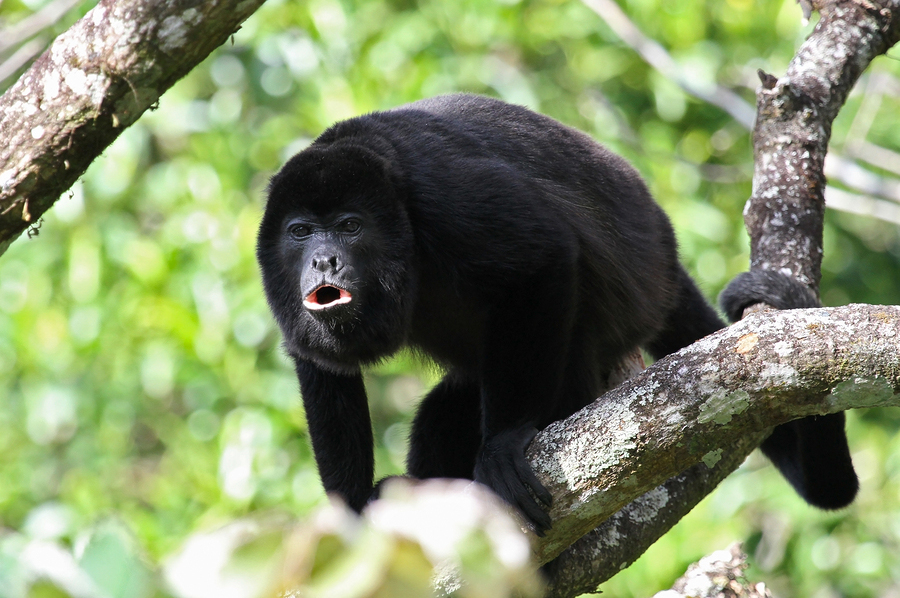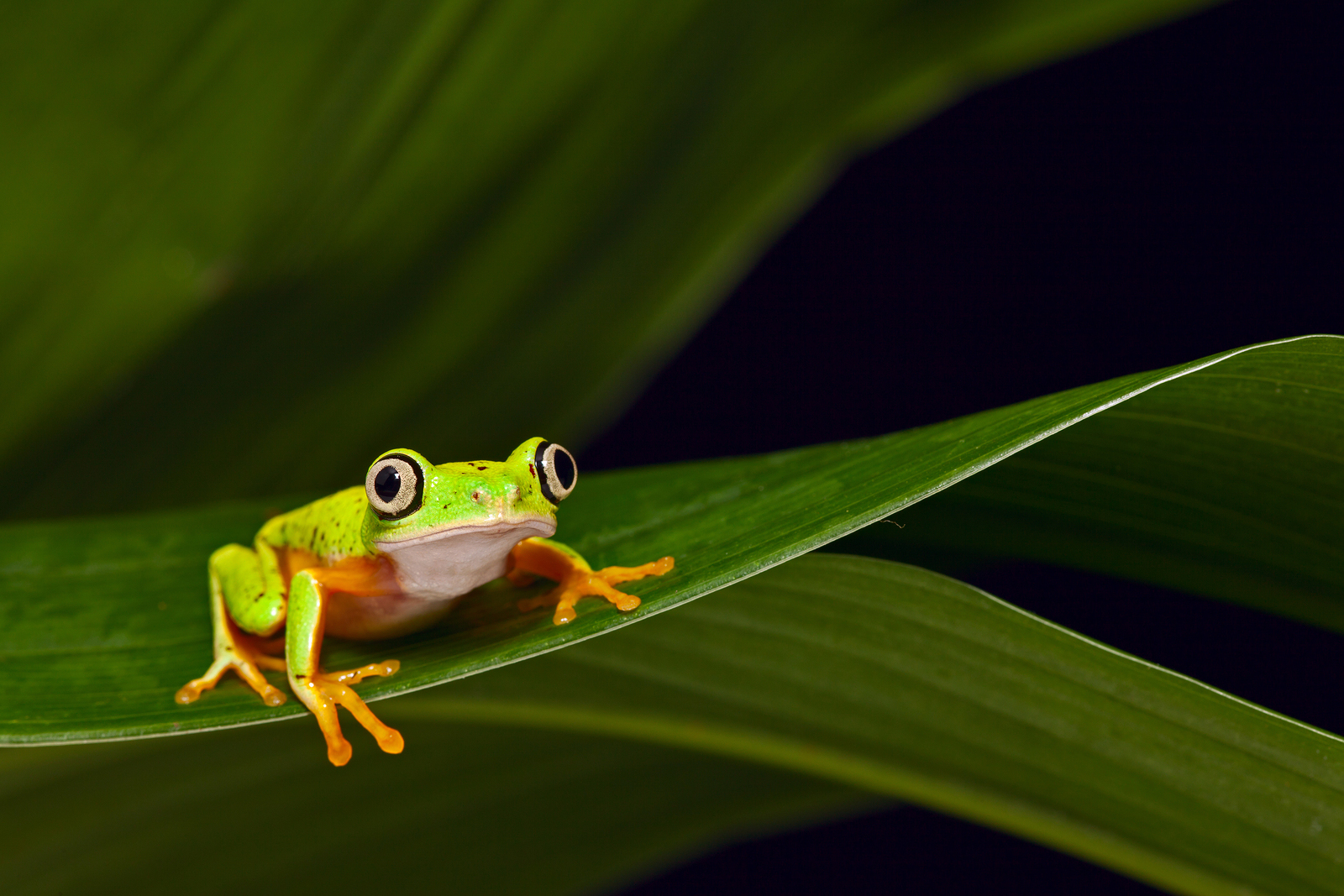Recording Nature By Sound
Air Date: Week of August 2, 2013

Howler monkeys are a part of the sound scape in Costa Rica’s La Selva Rainforest. (bigstockphotos.com)
New computer software can sift through thousands of hours of nature recordings to identify and map individual species. Mitch Aide, a researcher at the University of Puerto Rico, tells host Steve Curwood about how his team devised the systems and put them to work.
Transcript
CURWOOD: A healthy forest, especially in the tropics, is a noisy place.
[FOREST SOUNDS]
CURWOOD: There’s always something going on - insects buzzing, frogs peeping, birds calling to one another. This audio snap shot comes from El Verde field station in El Yunque National Forest, Puerto Rico, and is part of a new way to capture the sounds of nature known as the Automated Remote Biodiversity Monitoring Network. Mitch Aide is a professor of biology and tropical ecology at the University of Puerto Rico and a lead researcher on the project. He says to create a sonic fingerprint of a natural spot, the network records for a minute at a time, every ten minutes.
AIDE: What we’re doing is just putting microphones out in the field connected to an iPod, and we’ve developed an application that automates the collection of sound. The new part was that we moved the sounds from the field to the internet, and then provide them for people to visualize and listen to on the internet virtually in real time.
AIDE: So how much sound do you get?
CURWOOD: We’re capturing the whole soundscape, everything that’s making noise at a time. So we’re capturing the animals, the rain, the wind, an airplane flying over. We’re here in Puerto Rico where you can have a car drive by and you can hear the music or Reggaeton playing sometimes.

Rainforests are a particularly noisy place. (bigstockphoto.com))
[LAUGHS]
CURWOOD: So this has got to be hours and hours and hours and hours of tape.
AIDE: Yes. That’s where the second part of the project comes in, and that’s the software part. And we’ve developed a software that allows the user to produce a model that allows them to then analyze all of their data. So they can go in and produce a model for a specific song for a specific species, and that allows the computer to do the hard work and listen to hundreds of thousands of recordings.
CURWOOD: Well, let’s listen to one. We have one from Sabana Seca you sent us from Puerto Rico. It’s from July 7, 2013. Let’s take a listen.
[HIGH PITCHED CHIRPING]
AIDE: In Sabana Seca, we established a permanent station there because there was a new species of frog, a coquí. It’s called the Plains coquí. It was discovered about six or seven years ago, and, of course, there wasn’t much information on this species. So that’s one of the reasons we decided to put a permanent station there. Now we have over 200,000 recordings of this species, but in that particular recording that you’re hearing, there are at least four other species of frogs that are calling at the same time.

A yellow tree frog. (bigstockphoto.com)
CURWOOD: Now the coquí, this is the iconic animal in Puerto Rico.
AIDE: Yes. Coquí is the genus. There are around 14 species of coquí, and now with this new species, there’s one more to listen to. Each one of them has their own unique call. That’s why we can hear four, five of them at the same time in the same recording because there’s no overlap in the frequency that they’re using.
CURWOOD: Here’s another one. This is from Cabo Frio in Brazil.
[UNIQUE BIRD CALL]
CURWOOD: Professor, that recording is being labeled as part of the Biological Dynamics of Forest Fragments Project. Can you tell me about that project?
AIDE: Sure. This is a project that is organized by Gonzalo Fairdos, he’s a professor in Brazil. And Gonzalo along with his students are studying over 150 species of understory birds. They’re sampling many, many places within the Amazon forest. They had over 200,000 recordings and the software has helped them to organize them and begin creating models for some of those 150 species of birds they’re studying.
CURWOOD: As I understand it, you have over a million recordings by now. What are you doing with all that sound? How do biologists use this information?
AIDE: Each one of these recordings is virtually equivalent of a museum specimen. Today what most of the people that are using the system, they’re using it to create models to look at long-term change in populations. And one of the nice things about using sound is that it captures many of the species that are calling in a site at a time. And so one of the things that this allows us to do is follow the acoustics of a site over many, many years to see how species are coming or going, or how populations are declining across time with changes in climate change or habitat degradation.
CURWOOD: I’ve read that in Indonesia researchers are using a similar technology. They use that though to identify the sound of chainsaws so they can alert authorities to illegal logging. I wonder if you’ve considered that.
AIDE: No, but it doesn’t surprise me. Chainsaws, gunfire, all have characteristic sounds, and if you have enough examples, you can create these models that automate the identification and be able to alert the researcher, or the authorities in the case in Southeast Asia.
CURWOOD: So let’s take a listen to some more now. This is from La Selva Rainforest in Costa Rica.
[MONKEYS IN THE WILDERNESS]
CURWOOD: So, what are those sounds at the end? It kind of sounds like a dog barking.
AIDE: No, it’s probably a Howler monkey. The males will call early in the morning, late at night if they’re disturbed or even when a storm starts rolling you can hear the Howler monkeys calling from over a kilometer or two away.
CURWOOD: Now you have recordings from six different countries - all of these are in Latin America. Where do you want to go next with the technology?
AIDE: We’d love to expand this around the world. The project was initially funded by the National Science Foundation. And it was really done as a proof of concept. We’ve accomplished that part. And now we’re hoping that the attention the project is getting will help us get more funds so that we can put this in many, many sites in national parks, areas that are being rapidly changed, all around the world.
CURWOOD: Mitch Aide is a professor of biology and tropical ecology at the University of Puerto Rico, Rio Piedras. Thank you so much for taking the time today.
AIDE: Thank you, Steve.
Links
Living on Earth wants to hear from you!
Living on Earth
62 Calef Highway, Suite 212
Lee, NH 03861
Telephone: 617-287-4121
E-mail: comments@loe.org
Newsletter [Click here]
Donate to Living on Earth!
Living on Earth is an independent media program and relies entirely on contributions from listeners and institutions supporting public service. Please donate now to preserve an independent environmental voice.
NewsletterLiving on Earth offers a weekly delivery of the show's rundown to your mailbox. Sign up for our newsletter today!
 Sailors For The Sea: Be the change you want to sea.
Sailors For The Sea: Be the change you want to sea.
 The Grantham Foundation for the Protection of the Environment: Committed to protecting and improving the health of the global environment.
The Grantham Foundation for the Protection of the Environment: Committed to protecting and improving the health of the global environment.
 Contribute to Living on Earth and receive, as our gift to you, an archival print of one of Mark Seth Lender's extraordinary wildlife photographs. Follow the link to see Mark's current collection of photographs.
Contribute to Living on Earth and receive, as our gift to you, an archival print of one of Mark Seth Lender's extraordinary wildlife photographs. Follow the link to see Mark's current collection of photographs.
 Buy a signed copy of Mark Seth Lender's book Smeagull the Seagull & support Living on Earth
Buy a signed copy of Mark Seth Lender's book Smeagull the Seagull & support Living on Earth

